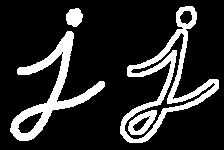1
2
3
4
5
6
7
8
9
10
11
12
13
14
15
16
17
18
19
20
21
22
23
24
25
26
27
28
29
30
31
32
33
34
35
36
37
38
39
40
41
42
43
44
45
46
47
48
49
50
51
52
53
54
55
56
57
58
59
60
61
62
63
64
65
66
67
68
69
70
71
72
73
74
75
76
77
78
79
80
81
82
83
84
85
86
87
88
89
90
91
92
93
94
95
96
97
98
99
100
101
102
103
104
105
106
107
108
109
110
111
112
113
114
115
116
117
118
119
120
121
122
123
124
125
126
127
128
129
130
131
132
133
134
135
136
137
138
139
140
141
142
143
144
145
146
147
148
149
150
151
152
153
154
155
156
157
158
159
160
161
162
163
164
165
166
|
More Morphology Transformations {#tutorial_opening_closing_hats}
===============================
@tableofcontents
@prev_tutorial{tutorial_erosion_dilatation}
@next_tutorial{tutorial_hitOrMiss}
| | |
| -: | :- |
| Original author | Ana Huamán |
| Compatibility | OpenCV >= 3.0 |
Goal
----
In this tutorial you will learn how to:
- Use the OpenCV function @ref cv::morphologyEx to apply Morphological Transformation such as:
- Opening
- Closing
- Morphological Gradient
- Top Hat
- Black Hat
Theory
------
@note The explanation below belongs to the book **Learning OpenCV** by Bradski and Kaehler.
In the previous tutorial we covered two basic Morphology operations:
- Erosion
- Dilation.
Based on these two we can effectuate more sophisticated transformations to our images. Here we
discuss briefly 5 operations offered by OpenCV:
### Opening
- It is obtained by the erosion of an image followed by a dilation.
\f[dst = open( src, element) = dilate( erode( src, element ) )\f]
- Useful for removing small objects (it is assumed that the objects are bright on a dark
foreground)
- For instance, check out the example below. The image at the left is the original and the image
at the right is the result after applying the opening transformation. We can observe that the
small dots have disappeared.

### Closing
- It is obtained by the dilation of an image followed by an erosion.
\f[dst = close( src, element ) = erode( dilate( src, element ) )\f]
- Useful to remove small holes (dark regions).

### Morphological Gradient
- It is the difference between the dilation and the erosion of an image.
\f[dst = morph_{grad}( src, element ) = dilate( src, element ) - erode( src, element )\f]
- It is useful for finding the outline of an object as can be seen below:

### Top Hat
- It is the difference between an input image and its opening.
\f[dst = tophat( src, element ) = src - open( src, element )\f]

### Black Hat
- It is the difference between the closing and its input image
\f[dst = blackhat( src, element ) = close( src, element ) - src\f]

Code
----
@add_toggle_cpp
This tutorial's code is shown below. You can also download it
[here](https://github.com/opencv/opencv/tree/4.x/samples/cpp/tutorial_code/ImgProc/Morphology_2.cpp)
@include cpp/tutorial_code/ImgProc/Morphology_2.cpp
@end_toggle
@add_toggle_java
This tutorial's code is shown below. You can also download it
[here](https://github.com/opencv/opencv/tree/4.x/samples/java/tutorial_code/ImgProc/opening_closing_hats/MorphologyDemo2.java)
@include java/tutorial_code/ImgProc/opening_closing_hats/MorphologyDemo2.java
@end_toggle
@add_toggle_python
This tutorial's code is shown below. You can also download it
[here](https://github.com/opencv/opencv/tree/4.x/samples/python/tutorial_code/imgProc/opening_closing_hats/morphology_2.py)
@include python/tutorial_code/imgProc/opening_closing_hats/morphology_2.py
@end_toggle
Explanation
-----------
-# Let's check the general structure of the C++ program:
- Load an image
- Create a window to display results of the Morphological operations
- Create three Trackbars for the user to enter parameters:
- The first trackbar **Operator** returns the kind of morphology operation to use
(**morph_operator**).
@snippet cpp/tutorial_code/ImgProc/Morphology_2.cpp create_trackbar1
- The second trackbar **Element** returns **morph_elem**, which indicates what kind of
structure our kernel is:
@snippet cpp/tutorial_code/ImgProc/Morphology_2.cpp create_trackbar2
- The final trackbar **Kernel Size** returns the size of the kernel to be used
(**morph_size**)
@snippet cpp/tutorial_code/ImgProc/Morphology_2.cpp create_trackbar3
- Every time we move any slider, the user's function **Morphology_Operations** will be called
to effectuate a new morphology operation and it will update the output image based on the
current trackbar values.
@snippet cpp/tutorial_code/ImgProc/Morphology_2.cpp morphology_operations
We can observe that the key function to perform the morphology transformations is @ref
cv::morphologyEx . In this example we use four arguments (leaving the rest as defaults):
- **src** : Source (input) image
- **dst**: Output image
- **operation**: The kind of morphology transformation to be performed. Note that we have
5 alternatives:
- *Opening*: MORPH_OPEN : 2
- *Closing*: MORPH_CLOSE: 3
- *Gradient*: MORPH_GRADIENT: 4
- *Top Hat*: MORPH_TOPHAT: 5
- *Black Hat*: MORPH_BLACKHAT: 6
As you can see the values range from \<2-6\>, that is why we add (+2) to the values
entered by the Trackbar:
@snippet cpp/tutorial_code/ImgProc/Morphology_2.cpp operation
- **element**: The kernel to be used. We use the function @ref cv::getStructuringElement
to define our own structure.
Results
-------
- After compiling the code above we can execute it giving an image path as an argument. Results using
the image: **baboon.png**:

- And here are two snapshots of the display window. The first picture shows the output after using
the operator **Opening** with a cross kernel. The second picture (right side, shows the result
of using a **Blackhat** operator with an ellipse kernel.

|